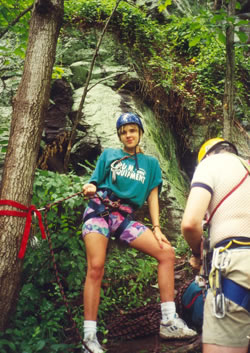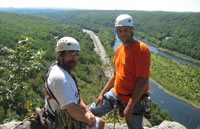You have to keep in mind that this is New Jersey. It isn't Yosemite and it isn't the Gunks , but there's a unique kind of cragging that goes on here. The majority of places in New Jersey are local crags. Detailed guide books are lacking. Getting to the crags in NJ sometimes involves a topographic map, a trail guide, and more than a little creativity.

From impressive rock walls to the scattered glaciated boulders that dot the landscape, there's a little something for everyone out here, whether you're a first-timer or a seasoned wall rat. Rock climbing may never become a mainstream sport in NJ, it's quietly becoming a popular way for locals and visitors alike to experience the tranquility of the Highlands. And from gaining first hand knowledge of the Highlands one gains insight on what is required to protect and preserve the Highlands.
Disclaimer: Rock Climbing is dangerous and will cause injury and or death to those untrained in activities such as rock climbing, bouldering and all associated activities. Climbers are responsible for their actions. Climbers must check with the appropriate land owners and land managers to gain access for climbing.
These climbing sites require knowledge of rock climbing. To effect a rescue in NJ is not easy. Cell phone service is not found at all of the climbing areas in NJ. Hunterdon County Park System has made bouldering illegal, while Somerset County Park System encourages bouldering in the Southern Highlands down at the Sourland Mountain Preserve.
The only offical guide book for climbing in NJ has it in a majority of climbing areas in NJ. It also lists the sites where climbing acess is not allowed by land managers. When you climb you assume the risks for your actions.
Climbing lessons are available at anyone of NJ's outdoor stores. EMS (Eastern Mountain Sports) provides a regular set of classes. For college students check with your college outdoor club. For folks looking for a very individual way to climb, find a climbing guide. Climbing guides that are listed with the American Mountain Guides Association have passed a strict certification program. Some of NJ indoor climbing gyms provide venues to learn about outdoor climbing.
Protect the environment. Climb clean. Follow the "leave no trace" philosphy. On NJ State Park Lands climbers are required to sign a yearly liability form. The Access Fund can provide information on climbing access and other issues facing climbing. In the summer and fall months rare and endangered falcons are found on NJ's cliffs and crags. Follow posted climbing closures. There is no climbing and or bouldering allowed on the Palisades.
NJ State Parks do not allow bolting of climbs. Pack out all trash. Follow climbing trails.
Allamuchy State Park: Easily the most "developed" climbing area in the state, Allamuchy has been popular with local underground craggers for years. Now that it's legal to climb there, climbers can enjoy the park's bouldering sites and even some longer wall climbs on Allamuchy Mountain with a drive-up-and-climb kind of convenience that you won't find elsewhere in the state. Enter off of Stephen's State Park Road in Warren County.

Wawayanda State Park: The most remote park in the New Jersey state park system is also home to some surprisingly good climbing. Since the waiver policy was put in place, climbers have begun to explore Wawayanda's backcountry crags and hidden rock faces. The park is a good 3-1/2 hours from southern New Jersey, most of the climbs require difficult hike-ins, and set routes are currently non-existent, but the area's climbing potential is huge. Located in the northern part of the state in Sussex County, take the Warwick Turnpike from West Milford. more...
Green Pond: Overlooking the swampy, overgrown Green Pond outside of Butler, NJ is "some of the best climbing in the state." Aside from a few scattered boulders, Green Pond offers a 150-plus foot vertical wall that stretches some 200 yards end to end. Access can be tough - it takes about 20 minutes to hike in from the road, plus the talus field - but the payoff is a virtually unclimbed wall and non-existent crowds. Not all of it is pretty, but it's a chance to get creative and create your own routes. Butler is in Morris County, and access is easiest via 287 to Route 23. Green Pond is not for the inexperienced. Green Pond is remote. Hiking and parking permits are available voa the Newark Watershed Office off Echo Lake Road.

Delaware Water Gap: Situated near the border of New Jersey and Pennsylvania, the Delaware Water Gap National Recreation Area is best known for its paddling and backcountry hiking, but the areas is becoming more popular with climbers as well. Several area climbing schools offer classes at the Water Gap, and a number of routes have gone up on the New Jersey side in recent years. From the east, take NJ Interstate 80 to Exit 34 and go 25 miles west to the town of Layton, NJ. Climbing at the Gap is not for the faint-hearted. Weather changes, exposure, aproach trails and other issues will impact your climbing. Follow National Park Service rules and regulations. Ice climbing is found at the Gap. more...
Somerset County boulders: Local, convenient, and plentiful, the bouldering areas in central New Jersey's Sourland Mountain Preserve were recently approved for climbing by the Somerset County Park Commission. The hills in this area are renowned for their boulder climbing, and now that it's legal to climb in Somerset County the local climbing scene is starting to venture out of the gyms. Remember though, several neighboring counties and landowners still prohibit access. Take 287 west to Hillsborough and enter via East Mountain Road. more...